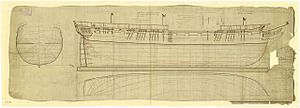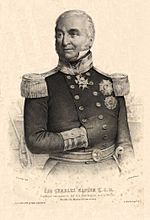HMS Galatea (1810) facts for kids
Quick facts for kids History |
|
|---|---|
| Name | HMS Galatea |
| Ordered | 12 May 1809 |
| Builder | Deptford Dockyard |
| Laid down | August 1809 |
| Launched | 31 August 1810 |
| Commissioned | September 1810 |
| Reclassified | Used as a coal hulk from August 1836 |
| Honours and awards |
Naval General Service Medal with clasp "Off Tamatave 20 May 1811" |
| Fate | Broken up in 1849 |
| General characteristics as built | |
| Class and type | 36-gun Apollo-class frigate |
| Tons burthen | 94730⁄94 (bm) |
| Length |
|
| Beam | 38 ft 3 in (11.7 m) |
| Depth of hold | 13 ft 3+1⁄2 in (4.1 m) |
| Sail plan | Full-rigged ship |
| Complement | 264 |
| Armament |
|
HMS Galatea was a fast sailing warship called a frigate. It was part of the Royal Navy, which is the United Kingdom's navy. The ship was built in London, England, and launched on August 31, 1810.
In 1811, Galatea took part in an important sea battle called the Battle of Tamatave. This battle helped the British control the seas east of Africa during the Napoleonic Wars. Later, in 1836, the ship was turned into a coal hulk, which means it was used to store coal. Galatea was taken apart in 1849.
Galatea During the Napoleonic Wars
Galatea officially joined the navy in September 1810. Captain Woodley Losack was its commander until 1815. He sailed the ship to the Cape of Good Hope, a famous point in South Africa, on December 31, 1810.
In May 1811, a group of French frigates, led by Commodore François Roquebert, sailed near Grand Port. They did not know that the nearby island, Isle de France (now called Mauritius), had been taken over by the British. The French ships managed to avoid a fight with a British group of ships.
Between May 7 and 9, the British frigates Galatea and Phoebe, along with the smaller ship Racehorse, saw the French frigates Renommée, Clorinde, and Néréide. Another British ship, Astraea, was nearby.
On May 14, the British ships Astraea, Phoebe, Galatea, and Racehorse sailed to Tamatave, a town in Madagascar. They arrived on May 20. The British ships saw the French ships and began to chase them. A fierce fight, known as the Battle of Tamatave, then began.
During this battle, the French ships Renommée and Clorinde heavily damaged Galatea. As a result, Galatea lost 16 sailors who were killed and 46 who were wounded. This was the highest number of casualties for any ship in the British group. Years later, in 1847, a special medal called the Naval General Service Medal was given to any surviving sailors who fought in this battle.
The British captured the French ship Renommée. Commodore Roquebert, the French commander, sacrificed his own ship and his life to help Clorinde and the damaged Néréide escape. Five days later, the British found Néréide at Tamatave. The British convinced the town's leader to surrender the town and Néréide without another fight.
The Royal Navy took the captured French ships and renamed them. Néréide became Madagascar, and Renommée became Java. This battle was the last major fight of the Mauritius campaign. After this, Galatea mostly sailed as a convoy escort, protecting groups of merchant ships for the rest of the war.
Galatea also took part in the War of 1812 between the United Kingdom and the United States. On September 27, 1812, Galatea left St Helena. It was escorting three ships that hunted whales. On October 31, Galatea and the whaling ships met two American warships. The American ships chased them, and one whaling ship was captured. However, Galatea managed to escape and safely reached Portsmouth, England.
On April 18, 1813, Galatea and another British ship, Spitfire, recaptured a brig (a type of sailing ship) named Fermina. On June 1, 1813, Galatea sailed to Lisbon, Portugal.
Galatea After the Wars
In October 1815, Galatea was put into storage at Portsmouth. It then underwent major repairs and was prepared for sea again between 1819 and 1826. These repairs cost a lot of money.
In August 1825, Captain Sir Charles Sullivan took command of Galatea. He sailed the ship along the coasts of Portugal and South America until 1829. From 1829 to 1832, Captain Charles Napier commanded Galatea. He once described the ship as having "the worst reputation in the Navy."
Between January and May 1829, Captain Napier added an experimental system to Galatea. This system used paddles that the crew could turn with winches (cranks) on the main deck. These paddles were helpful for moving the ship at speeds of up to 3 knots (about 3.5 miles per hour) when there was no wind. On September 12, 1831, Galatea even used these paddles to tow a much larger warship, Caledonia.
During this time, Galatea sailed to the Caribbean twice. It visited places like Jamaica, Havana, Cuba, and Tampico, Mexico. In 1830, the ship was sent to Lisbon to demand that British merchant ships, which had been taken by the Portuguese government, be returned. In 1831, Galatea helped protect British interests in the Azores islands during a conflict there. Captain Napier left Galatea in 1832.
The End of Galatea
Between August and September 1836, Galatea was prepared at Plymouth to be a receiving ship (a ship used as a barracks or office) and a coal depot (a place to store coal) for Jamaica. It was then moved to Jamaica in 1840. Galatea was finally taken apart in 1849, following an order from the Admiralty.




